A Novel Single-Fed Dual-Band Dual-Circularly Polarized Dielectric Resonator Antenna for 5G Sub-6GHz Applications
Abstract
:1. Introduction
2. Antenna Design and Analysis
Linear Polarized DRA
3. Impedance Matching and 3-dB Axial Ratio Bandwidth Improving Operation
4. Simulated Result of Proposed RDRA
5. E-Field Distributions Because of Parasitic Patch
6. Fabrication and Experimental Verification
7. Conclusions
Author Contributions
Funding
Institutional Review Board Statement
Informed Consent Statement
Data Availability Statement
Acknowledgments
Conflicts of Interest
References
- Chen, H.-D.; Tsai, Y.-C.; Sim, C.-Y.-D.; Kuo, C. Broadband Eight-Antenna Array Design for Sub-6 GHz 5G NR Bands Metal-Frame Smartphone Applications. IEEE Antennas Wirel. Propag. Lett. 2020, 19, 1078–1082. [Google Scholar] [CrossRef]
- Jha, K.R.; Jibran, Z.A.P.; Singh, C.; Sharma, S.K. 4-Port MIMO Antenna Using Common Radiator on a Flexible Substrate for Sub-1GHz, Sub-6GHz 5G NR, and Wi-Fi 6 Applications. IEEE Open J. Antennas Propag. 2021, 2, 689–701. [Google Scholar] [CrossRef]
- Zhou, Y.; Jiao, Y.; Weng, Z.; Ni, T. A Novel Single-Fed Wide Dual-Band Circularly polarized Dielectric Resonator Antenna. IEEE Antennas Wirel. Propag. Lett. 2016, 15, 930–933. [Google Scholar] [CrossRef]
- Kiani, S.H.; Altaf, A.; Abdullah, M.; Muhammad, F.; Shoaib, N.; Anjum, M.R.; Damaševičius, R.; Blažauskas, T. Eight element side edged framed MIMO antenna array for future 5G smart phones. Micromachines 2020, 11, 956. [Google Scholar] [CrossRef] [PubMed]
- Lin, K.Z.; Wu, T.T. Dual-band circularly polarized hybrid dielectric resonator antenna with gain enhancement. AEU—Int. J. Electron. Commun. 2022, 146, 154121, ISSN 1434-8411. [Google Scholar] [CrossRef]
- Kiani, S.H.; Altaf, A.; Anjum, M.R.; Afridi, S.; Arain, Z.A.; Anwar, S.; Khan, S.; Alibakhshikenari, M.; Lalbakhsh, A.; Khan, M.A.; et al. Mimo antenna system for modern 5g handheld devices with healthcare and high rate delivery. Sensors 2021, 21, 7415. [Google Scholar] [CrossRef] [PubMed]
- Gupta, A.; Gangwar, R.K. Dual-Band Circularly polarized Aperture Coupled Rectangular Dielectric Resonator Antenna for Wireless Applications. IEEE Access 2018, 6, 11388–11396. [Google Scholar] [CrossRef]
- Xu, H.; Chen, Z.; Liu, H.; Chang, L.; Huang, T.; Ye, S.; Zhang, L.; Du, C. Single-Fed Dual-Circularly polarized Stacked Dielectric Resonator Antenna for K/Ka-Band UAV Satellite Communications. IEEE Trans. Veh. Technol. 2022, 71, 4449–4453. [Google Scholar] [CrossRef]
- Keyrouz, S.; Caratelli, D. Dielectric Resonator Antennas: Basic Concepts, Design Guidelines, and Recent Developments at Millimeter-Wave Frequencies. Int. J. Antennas Propag. 2016, 2016, 6075680. [Google Scholar] [CrossRef]
- Serghiou, D.; Khalily, M.; Singh, V.; Araghi, A.; Tafazolli, R. Sub-6 GHz Dual-Band 8 × 8 MIMO Antenna for 5G Smartphones. IEEE Antennas Wirel. Propag. Lett. 2020, 19, 1546–1550. [Google Scholar] [CrossRef]
- Illahi, U.; Iqbal, J.; Sulaiman, M.I.; Alam, M.; Su’ud, M.M.; Khattak, M.I. Design and development of a singly-fed circularly polarized rectangular dielectric resonator antenna for WiMAX/Satellite/5G NR band applications. AEU 2020, 126, 153443. [Google Scholar] [CrossRef]
- Petosa, A. Dielectric Resonator Antenna Handbook; Artech House: Norwood, MA, USA, 2007. [Google Scholar]
- Leung, K.W.; Wong, W.C.; Luk, K.M.; Yung, E.K.N. ‘Circular-polarised dielectric resonator antenna excited by dual conformal strips. Electron. Lett. 2000, 36, 484–486. [Google Scholar] [CrossRef]
- Wang, X.-C.; Sun, L.; Lu, X.-L.; Liang, S.; Lu, W.-Z. Single-feed dual-band circularly polarized dielectric resonator antenna for CNSS applications. IEEE Trans. Antennas Propag. 2017, 65, 4283–4287. [Google Scholar] [CrossRef]
- Fakhte, S.; Oraizi, H.; Karimian, R.; Fakhte, R. A new wideband cir-cularly polarized stair-shaped dielectric resonator antenna. IEEE Trans. Antennas Propag. 2015, 63, 1828–1832. [Google Scholar] [CrossRef]
- Wang, K.X.; Wong, H. A circularly polarized antenna by using rotated-stair dielectric resonator. IEEE Antennas Wirel. Propag. Lett. 2015, 14, 787–790. [Google Scholar] [CrossRef]
- Fang, X.S.; Leung, K.W.; Lim, E.H.; Chen, R.S. Compact differential rectangular dielectric resonator antenna. IEEE Antennas Wirel. Propag. Lett. 2010, 9, 662–665. [Google Scholar] [CrossRef]
- Long, R.T.; Dorris, R.J.; Long, S.A.; Khayat, M.A.; Williams, J.T. Use of parasitic strip to produce circular polarisation and increased bandwidth for cylindrical dielectric resonator antenna. Electron. Lett. 2001, 37, 406–408. [Google Scholar] [CrossRef]
- Leung, K.W.; Ng, H.K. Theory and experiment of circularly polarized dielectric resonator antenna with a parasitic patch. IEEE Trans. Antennas Propag. 2003, 51, 405–412. [Google Scholar] [CrossRef]
- Leung, K.W. Conformal strip excitation of dielectric resonator antenna. IEEE Trans. Antennas Propag. 2000, 48, 961–967. [Google Scholar] [CrossRef]
- Li, R.; Dejean, G.; Laskar, J.; Tentzeris, M.M. Investigation of circularly polarized loop antennas with a parasitic element for band-width enhancement. IEEE Trans. Antennas Propag. 2005, 53, 3930–3939. [Google Scholar]
- Sulaiman, M.I.; Khamas, S.K. A singly fed wideband circularly polarized dielectric resonator antenna using concentric open half-loops. IEEE Antennas Wirel. Propag. Lett. 2011, 10, 1305–1308. [Google Scholar] [CrossRef]
- Abedian, M.; Rahim, S.K.A.; Danesh, S.; Jamaluddin, M.H.; Islam, M.T. Compact wideband circularly polarised dielectric resonator antenna. Electron. Lett. 2016, 53, 5–6. [Google Scholar] [CrossRef]
- CST Reference Manual, Comput. Simul. Technol., Darmstadt, Germany. 2017. Available online: https://www.microwavejournal.com/authors/2519-ansys-canonsburg-pa (accessed on 2 April 2022).
- Li, B.; Leung, K.W. Strip-fed rectangular dielectric resonator antennas with/without a parasitic patch. IEEE Trans. Antennas Propag. 2005, 53, 2200–2207. [Google Scholar]
- Lim, E.H.; Leung, K.W.; Fang, X. The compact circularly-polarized hollow rectangular dielectric resonator antenna with an underlaid quadrature coupler. IEEE Trans. Antennas Propag. 2010, 59, 288–293. [Google Scholar] [CrossRef]
- Iqbal, J.; Illahi, U.; Sulaiman, M.I.; Alam, M.M.; Su’ud, M.M.; Yasin, M.N.M. Mutual coupling reduction using hybrid technique in wideband circularly polarized MIMO antenna for WiMAX applications. IEEE Access 2019, 7, 40951–40958. [Google Scholar] [CrossRef]
- Fang, X.; Leung, K.W.; Lim, E.H. Singly-fed dual-band circularly polarized dielectric resonator antenna. IEEE Antennas Wirel. Propag. Lett. 2014, 13, 995–998. [Google Scholar] [CrossRef]
- Mongia, R. Theoretical and experimental resonant frequencies of rectangular dielectric resonators. IEE Proc. H (Microw. Antennas Propag.) 1992, 139, 98–104. [Google Scholar] [CrossRef]
- Abdulmajid, A.A.; Khalil, Y.; Khamas, S. Higher-order-mode cir-cularly polarized two-layer rectangular dielectric resonator antenna. IEEE Antenna Wirel. Propag. Lett. 2018, 17, 1114–1117. [Google Scholar] [CrossRef]
- Alieldin, A.; Huang, Y.; Stanley, M.; Joseph, S.D.; Lei, D. A 5G MIMO Antenna for Broadcast and Traffic Communication Topologies Based on Pseudo Inverse Synthesis. IEEE Access 2018, 6, 65935–65944. [Google Scholar] [CrossRef]
- Huang, H.; Li, X.; Liu, Y. 5G MIMO Antenna Based on Vector Synthetic Mechanism. IEEE Antennas Wirel. Propag. Lett. 2018, 17, 1052–1055. [Google Scholar] [CrossRef]
- Sim, C.-Y.-D.; Chen, H.-D.; Kulkarni, J.; Lo, J.-J.; Hsuan, Y.-C. Recent Designs to Achieving Wideband MIMO Antenna for 5G NR Sub-6GHz Smartphone Applications. In Proceedings of the 2020 International Symposium on Antennas and Propagation (ISAP), Osaka, Japan, 25–28 January 2021; pp. 417–418. [Google Scholar] [CrossRef]
- Das, G.; Sharma, A.; Gangwar, R.; Sharawi, M. Compact Back to Back DRA Based Four Port MIMO Antenna System with Bi-directional Diversity. Electron. Lett. 2018, 54, 884–886. [Google Scholar] [CrossRef]
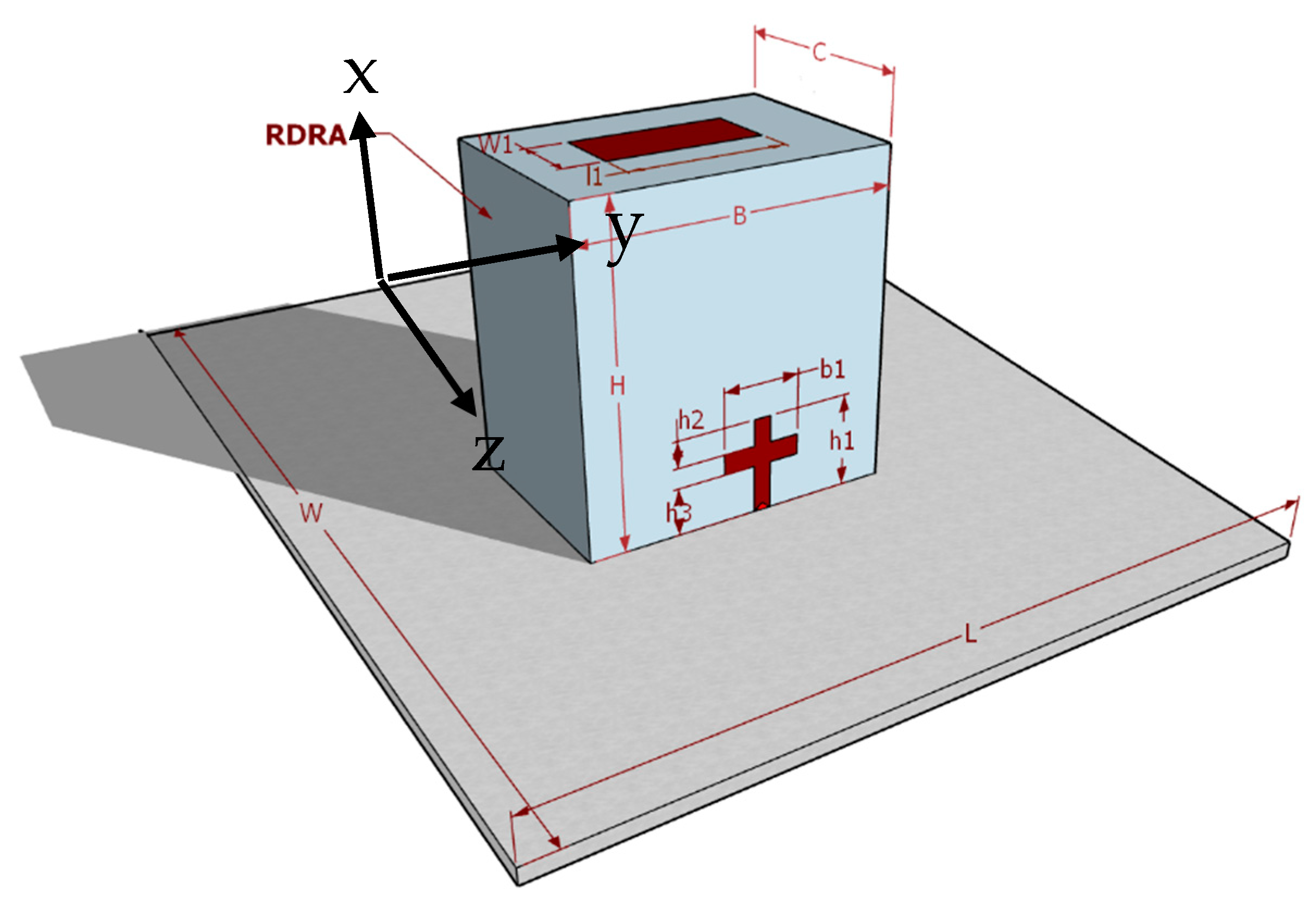
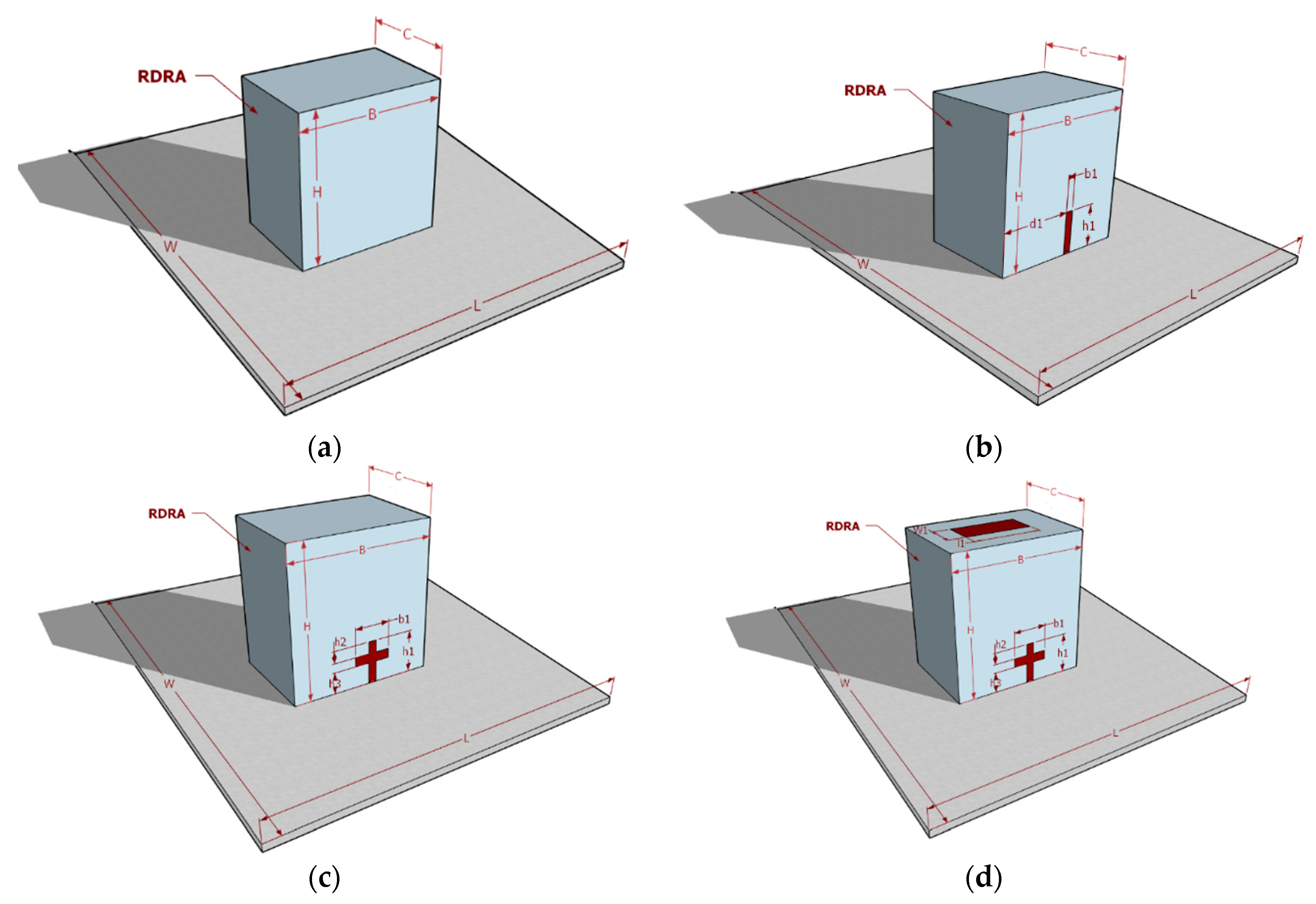
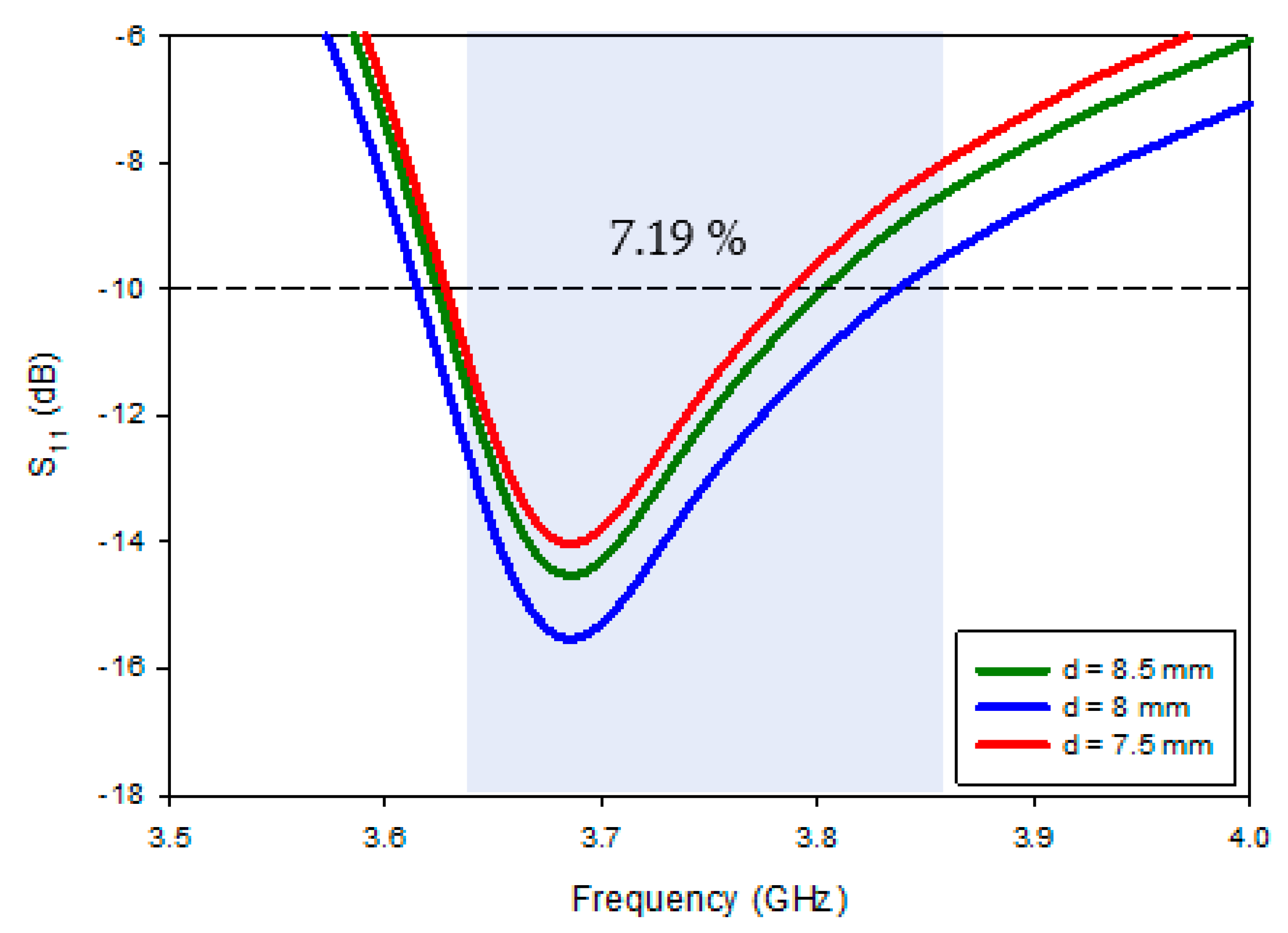
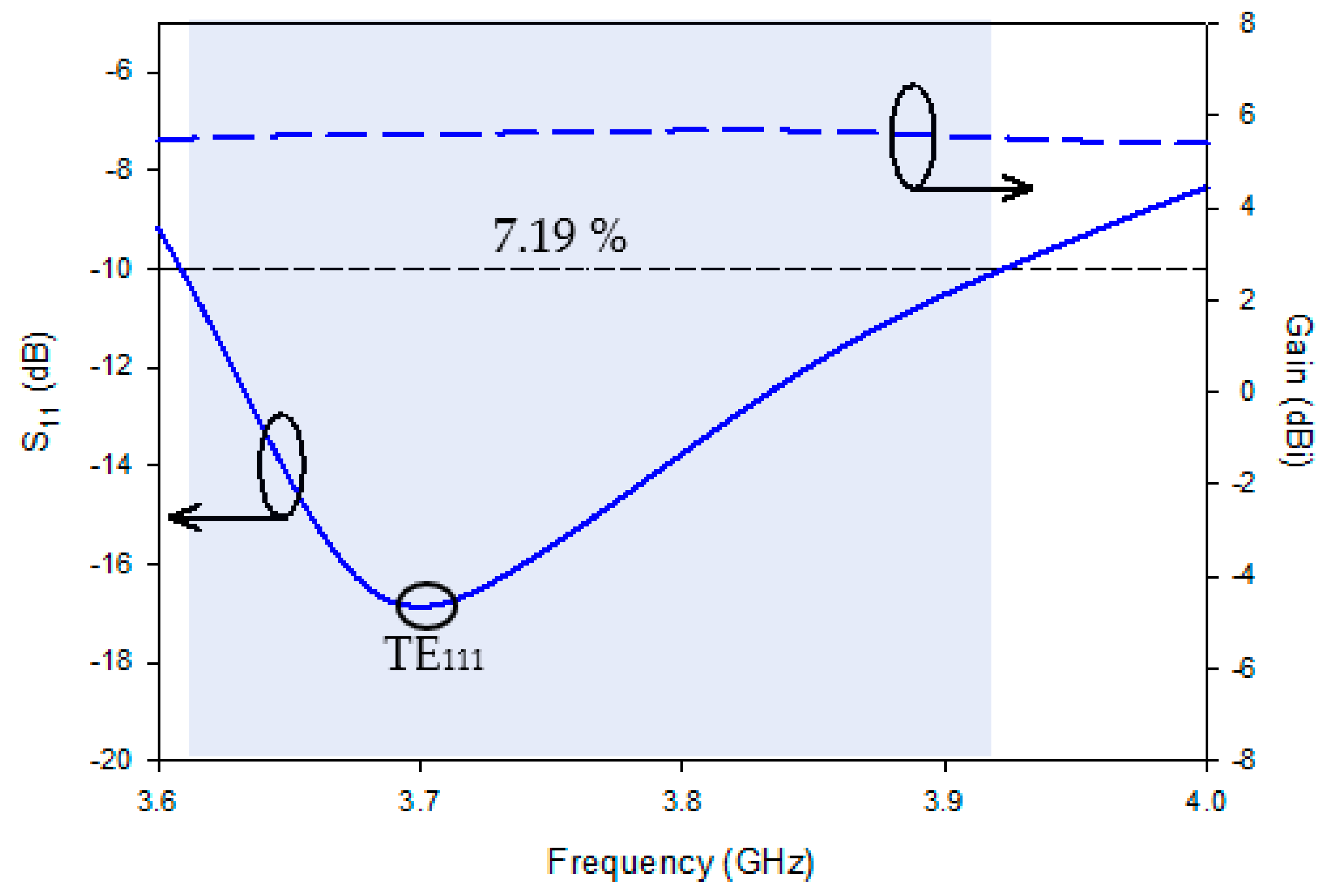
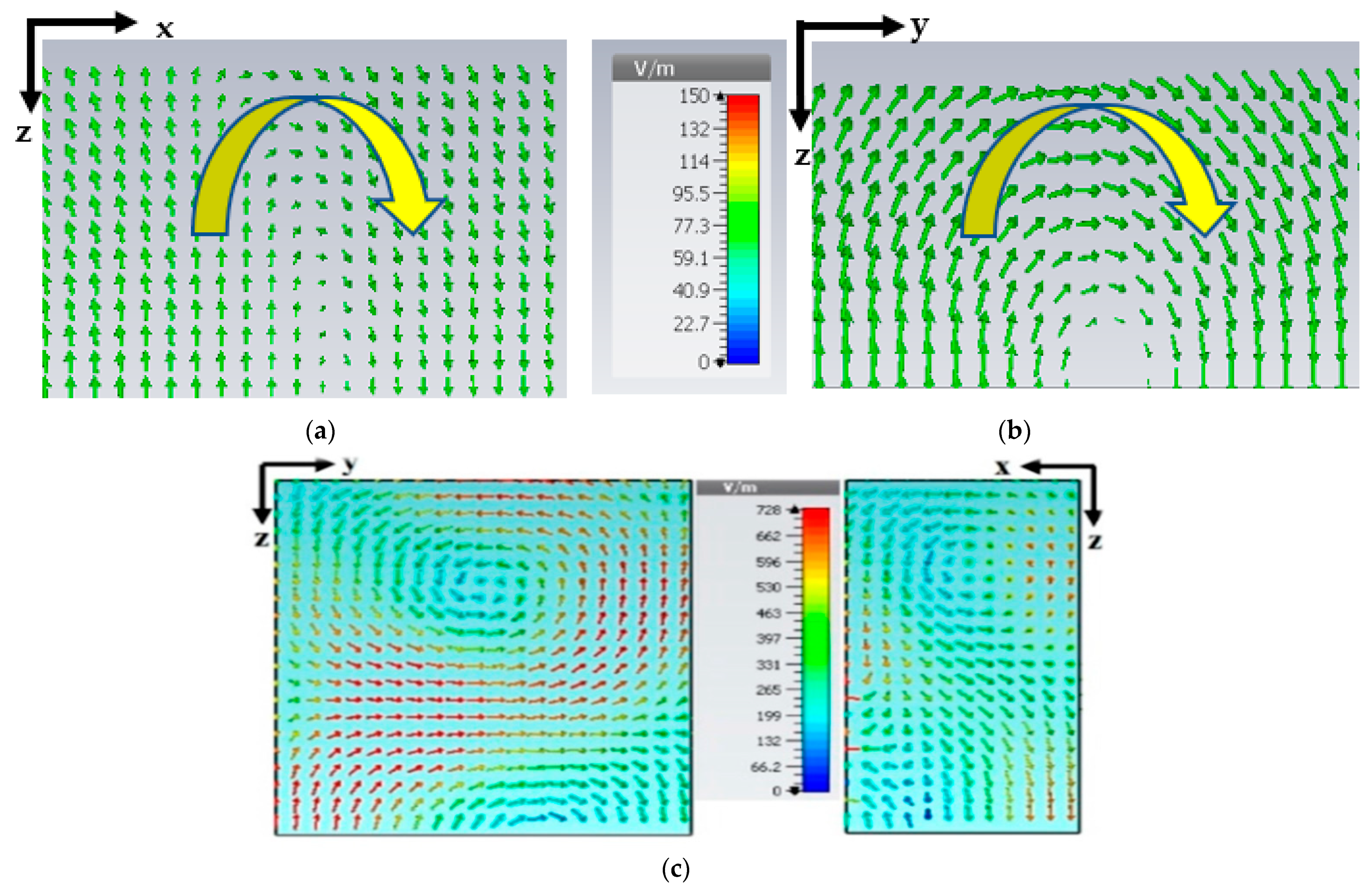


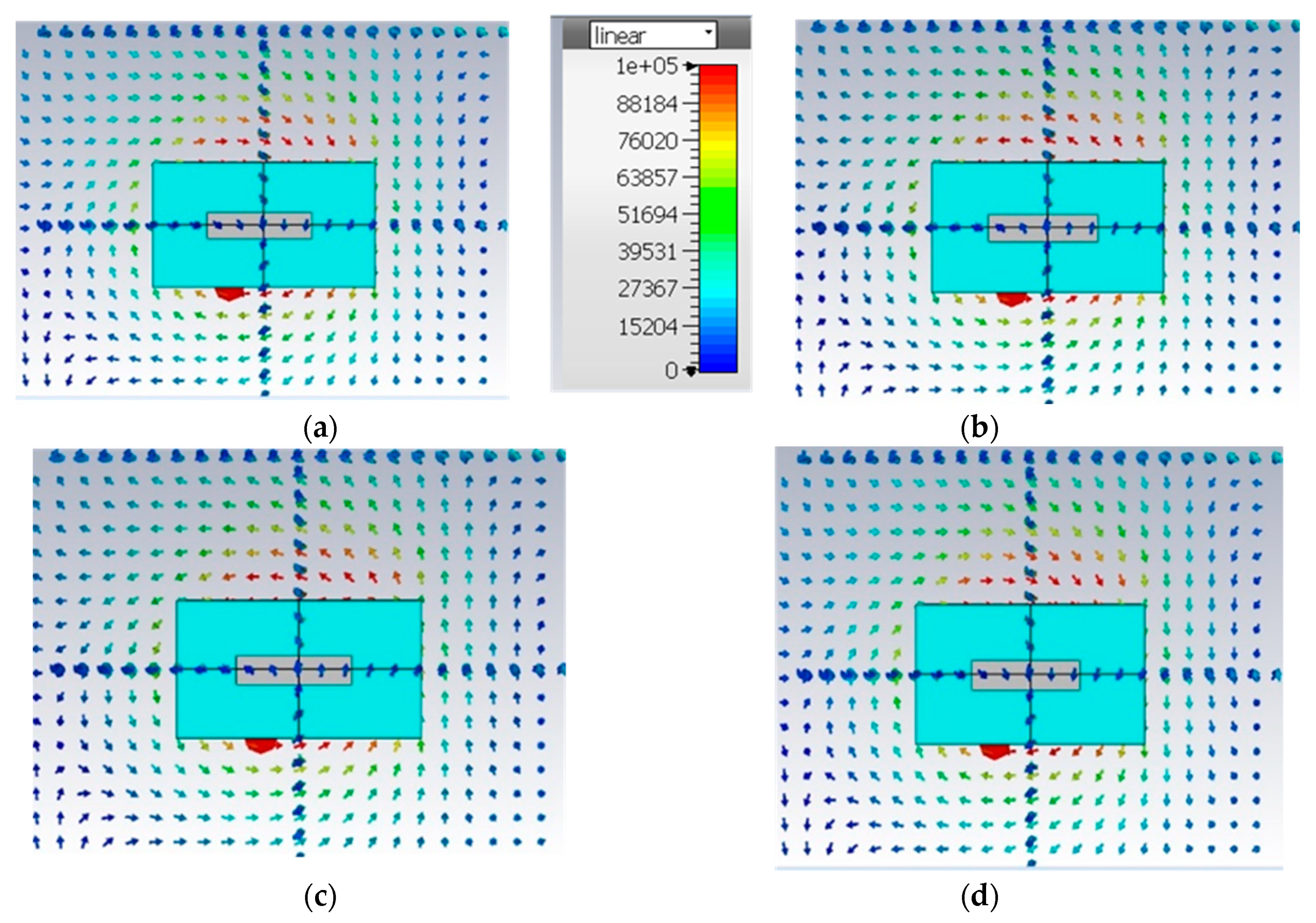
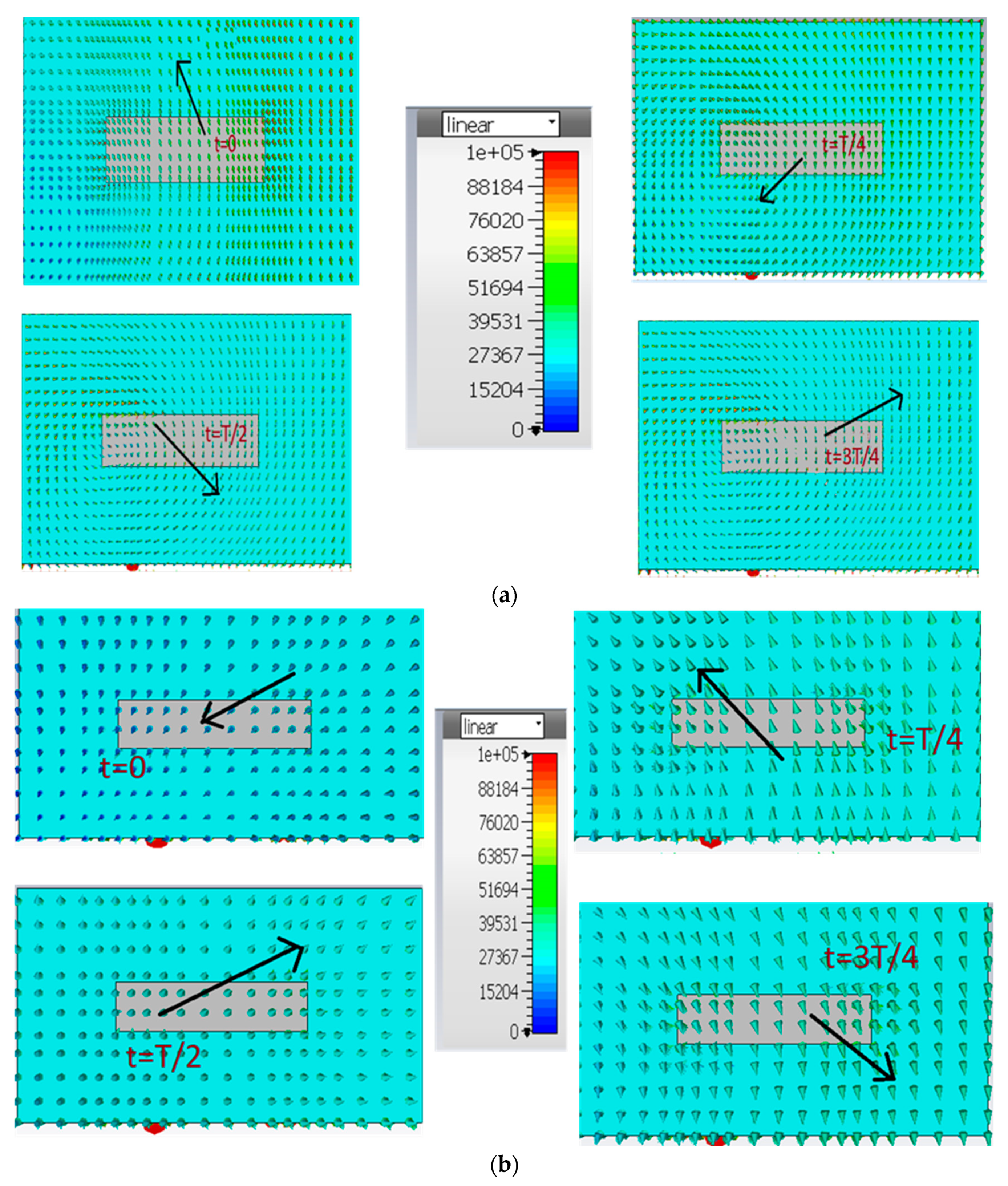

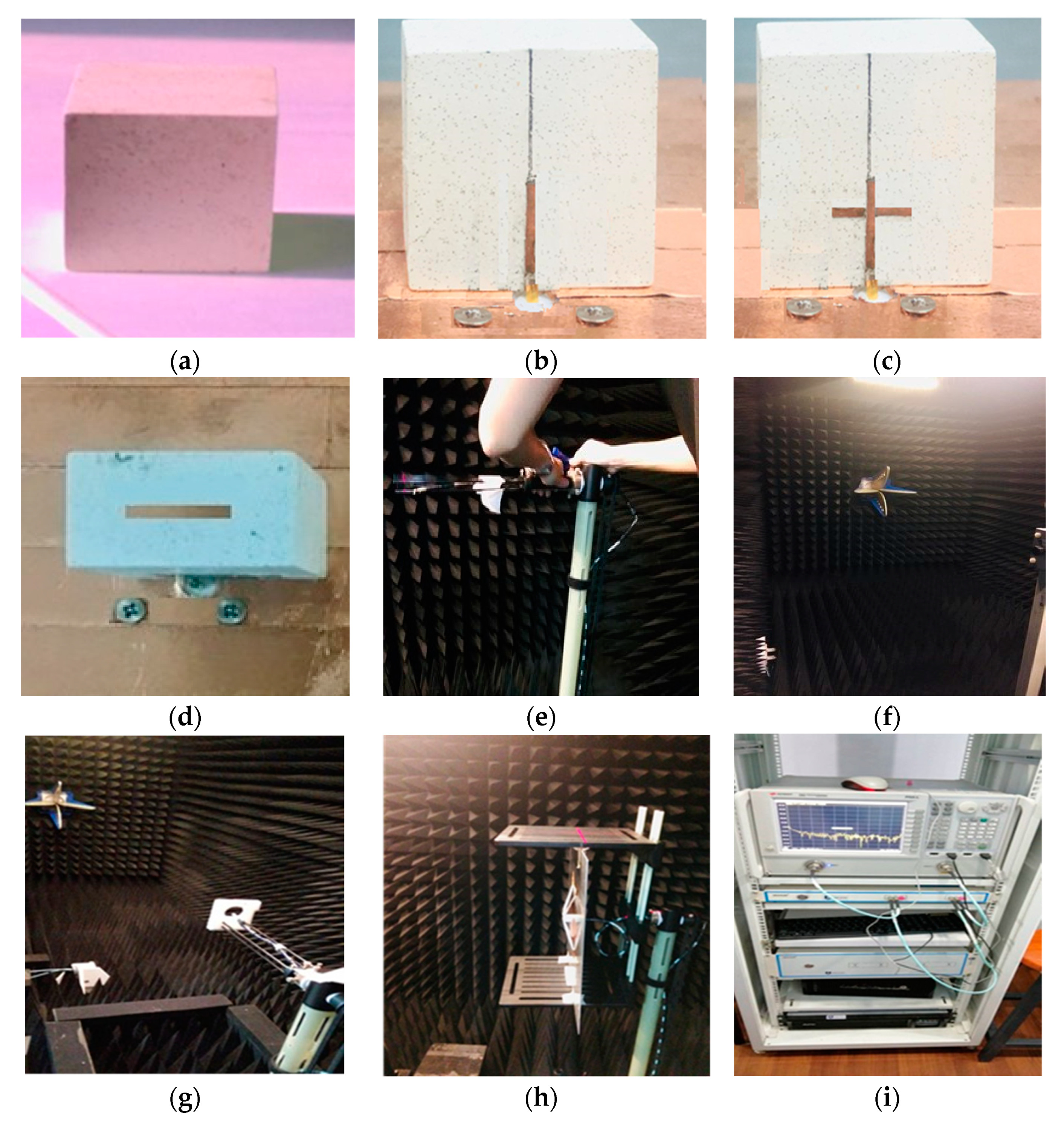

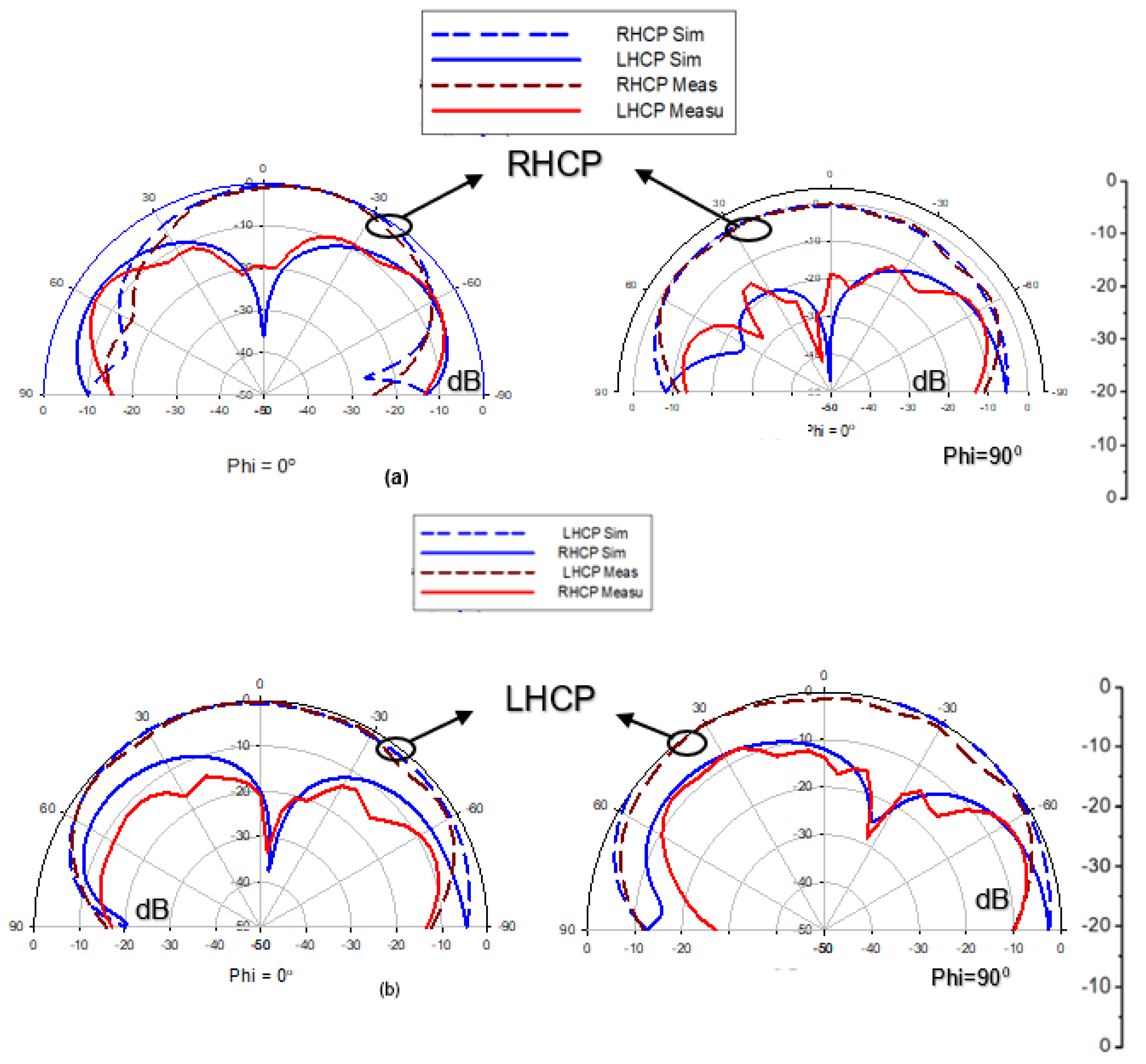
| Parameter | Dimension |
|---|---|
| H | 26.1 |
| B | 25.4 |
| C | 14.3 |
| h1 | b1 | 10-B S11 Bandwidth (%) |
|---|---|---|
| 10.75 | 0.5 | 5.43 |
| 5.18 | ||
| 0.75 | 5.92 | |
| 4.65 | ||
| 4.69 | ||
| 4.92 | ||
| 5.17 | ||
| 5.42 | ||
| 5.96 | ||
| 6.23 | ||
| 6.58 | ||
| 11.75 | 1 | 6.89 |
| 7.19 | ||
| 7.01 | ||
| 6.75 | ||
| 6.51 | ||
| 1.5 | 4.90 | |
| 12.75 | 1.75 | 4.42 |
| 4.20 | ||
| 3.97 | ||
| 3.75 | ||
| 3.54 | ||
| 2 | 3.34 | |
| 5.91 |
| Antenna (RDRA) | Lower-Band BW (|S11| < −10 dB) | Upper-Band BW (|S11| < −10 dB) | Lower-Band 3-dB ARBW | Upper-Band 3-dB ARBW |
|---|---|---|---|---|
| Single feed | 7.99% | 0 | 0 | 0 |
| Cross-shape feed | 5.2% | 19.2% | 12% | 24.63% |
| Proposed RDRA | 6.4% | 25.26% | 12.6% | 27.82% |
| Ref | DRA Shape | CP Tech | Lower-Band 3-dB ARBW (%) | Upper-Band 3-dB ARBW (%) | Single Fed Dual Band Dual CP | Structure |
|---|---|---|---|---|---|---|
| [3] | CDRA | A Pair Of Symmetrical Notches Are Carved Out From The Cylindrical Dra | 15.8 | 5.02 | No | Complicated |
| [5] | Hybrid DRA | DRA Corners Along The Diagonal Are Cut Off From The Rectangular DRA. | 20 | 21 | YES | Complicated |
| [7] | RDRA | Parasitic patch/Triangular Ring shape aperture | 2.29 | 3.04 | YES | Simple |
| [8] | RDRA | Multi layering/metallic strip on top | 5.2 | 4.1 | YES | Complicated |
| [9] | FSS | FSS-Integrated Polarization Rotation AMC | 2.4 | 4.8 | YES | Complicated |
| Proposed RDRA | RDRA | Cross-shape/Floating parasitic metallic patch on top | 12.6 | 27.82 | YES | Simple |
Publisher’s Note: MDPI stays neutral with regard to jurisdictional claims in published maps and institutional affiliations. |
© 2022 by the authors. Licensee MDPI, Basel, Switzerland. This article is an open access article distributed under the terms and conditions of the Creative Commons Attribution (CC BY) license (https://creativecommons.org/licenses/by/4.0/).
Share and Cite
Iqbal, J.; Illahi, U.; Khan, M.A.; Rauf, A.; Ali, E.M.; Bari, I.; Ali, H.; Khan, M.A.; Alibakhshikenari, M.; Dalarsson, M. A Novel Single-Fed Dual-Band Dual-Circularly Polarized Dielectric Resonator Antenna for 5G Sub-6GHz Applications. Appl. Sci. 2022, 12, 5222. https://doi.org/10.3390/app12105222
Iqbal J, Illahi U, Khan MA, Rauf A, Ali EM, Bari I, Ali H, Khan MA, Alibakhshikenari M, Dalarsson M. A Novel Single-Fed Dual-Band Dual-Circularly Polarized Dielectric Resonator Antenna for 5G Sub-6GHz Applications. Applied Sciences. 2022; 12(10):5222. https://doi.org/10.3390/app12105222
Chicago/Turabian StyleIqbal, Javed, Usman Illahi, Muhammad Abbas Khan, Abdul Rauf, Esraa Mousa Ali, Inam Bari, Haider Ali, Muhammad Amir Khan, Mohammad Alibakhshikenari, and Mariana Dalarsson. 2022. "A Novel Single-Fed Dual-Band Dual-Circularly Polarized Dielectric Resonator Antenna for 5G Sub-6GHz Applications" Applied Sciences 12, no. 10: 5222. https://doi.org/10.3390/app12105222
APA StyleIqbal, J., Illahi, U., Khan, M. A., Rauf, A., Ali, E. M., Bari, I., Ali, H., Khan, M. A., Alibakhshikenari, M., & Dalarsson, M. (2022). A Novel Single-Fed Dual-Band Dual-Circularly Polarized Dielectric Resonator Antenna for 5G Sub-6GHz Applications. Applied Sciences, 12(10), 5222. https://doi.org/10.3390/app12105222










